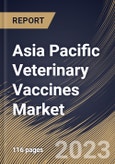Food security is being threatened by new and exotic animal diseases, which increasingly threaten human and animal health. Pathogen transmission within and across species is made easier by the growth in both human and animal populations, environmental deterioration of trade and travel. The majority of the region has seen an increase in commercial food animal production due to greater demand for animal protein. Public health is seriously threatened by newly emerging zoonotic diseases in both companions and farmed animals.
Some zoonotic diseases can also spread through ingested food, highlighting the significance of maintaining both good animal health and proper food handling, hygiene, storage, and preparation standards. In addition, some diseases can be conveyed to humans through intimate contact with animals or by contact between wild animals and domestic animals.
Vaccination is a crucial step in preventing diseases in both people and animals. Vaccines can protect humans from illness as well as prevent animals from illness, minimizing suffering in both cases. For example, although some zoonotic viruses, like salmonella, may not pose major health risks to poultry, boosting salmonella vaccination in chickens in the early 2000s successfully reduced its prevalence in human disease.
India's economy, in terms of income, employment, and foreign exchange profits, heavily depends on the livestock industry. The demand for animal products has grown significantly due to the ongoing economic expansion and rising domestic income. Due to this, livestock production has rapidly increased over the past 20 years, especially for exports. The majority of the world's buffalo meat exports come from India. India exported 1.24 million tons of deboned buffalo meat in 2018-19, equivalent to 2.0 million tons of dressed buffalo carcasses valued at Indian Rupees 25,168 million (US$ 3.61 billion). There are 111 contemporary meat processing facilities, several completely integrated from slaughter to the manufacturing of frozen buffalo meat with rendering and wastewater treatment plants to enable environmentally friendly, secure production. This is anticipated to propel market growth in the region.
The China market dominated the Asia Pacific Veterinary Vaccines Market by Country in 2022, and would continue to be a dominant market till 2029; thereby, achieving a market value of $1,240.4 million by 2029. The Japan market is experiencing a CAGR of 5.2% during (2023-2029). Additionally, The India market would showcase a CAGR of 6.7% during (2023-2029).
Based on Route of Administration, the market is segmented into Injection Vaccines, Oral Vaccines and Intranasal/Spray Vaccines. Based on Type, the market is segmented into Livestock Vaccines, Porcine Vaccines, Companion Animal Vaccines, Poultry Vaccines, Aquaculture Vaccines and Others. Based on Technology, the market is segmented into Live Attenuated Vaccines, Inactivated Vaccines, Toxoid Vaccines, Recombinant Vaccines and Others. Based on Distribution Channel, the market is segmented into Veterinary Hospitals, Veterinary Clinics and Retail Pharmacies. Based on countries, the market is segmented into China, Japan, India, South Korea, Australia, Malaysia, and Rest of Asia Pacific.
The market research report covers the analysis of key stake holders of the market. Key companies profiled in the report include Zoetis, Inc., Merck & Co., Inc., Boehringer Ingelheim International GmbH, Elanco Animal Health, Inc., Virbac, Ceva Santé Animale, Neogen Corporation, Intas Pharmaceuticals Ltd. and Laboratoire LCV.
Scope of the Study
By Route of Administration
- Injection Vaccines
- Oral Vaccines
- Intranasal/Spray Vaccines
By Type
- Livestock Vaccines
- Porcine Vaccines
- Companion Animal Vaccines
- Poultry Vaccines
- Aquaculture Vaccines
- Others
By Technology
- Live Attenuated Vaccines
- Inactivated Vaccines
- Toxoid Vaccines
- Recombinant Vaccines
- Others
By Distribution Channel
- Veterinary Hospitals
- Veterinary Clinics
- Retail Pharmacies
By Country
- China
- Japan
- India
- South Korea
- Australia
- Malaysia
- Rest of Asia Pacific
Key Market Players
List of Companies Profiled in the Report:
- Zoetis, Inc.
- Merck & Co., Inc.
- Boehringer Ingelheim International GmbH
- Elanco Animal Health, Inc.
- Virbac
- Ceva Santé Animale
- Neogen Corporation
- Intas Pharmaceuticals Ltd.
- Laboratoire LCV
Unique Offerings
- Exhaustive coverage
- The highest number of Market tables and figures
- Subscription-based model available
- Guaranteed best price
- Assured post sales research support with 10% customization free
Table of Contents
Companies Mentioned
- Zoetis, Inc.
- Merck & Co., Inc.
- Boehringer Ingelheim International GmbH
- Elanco Animal Health, Inc.
- Virbac
- Ceva Santé Animale
- Neogen Corporation
- Intas Pharmaceuticals Ltd.
- Laboratoire LCV








